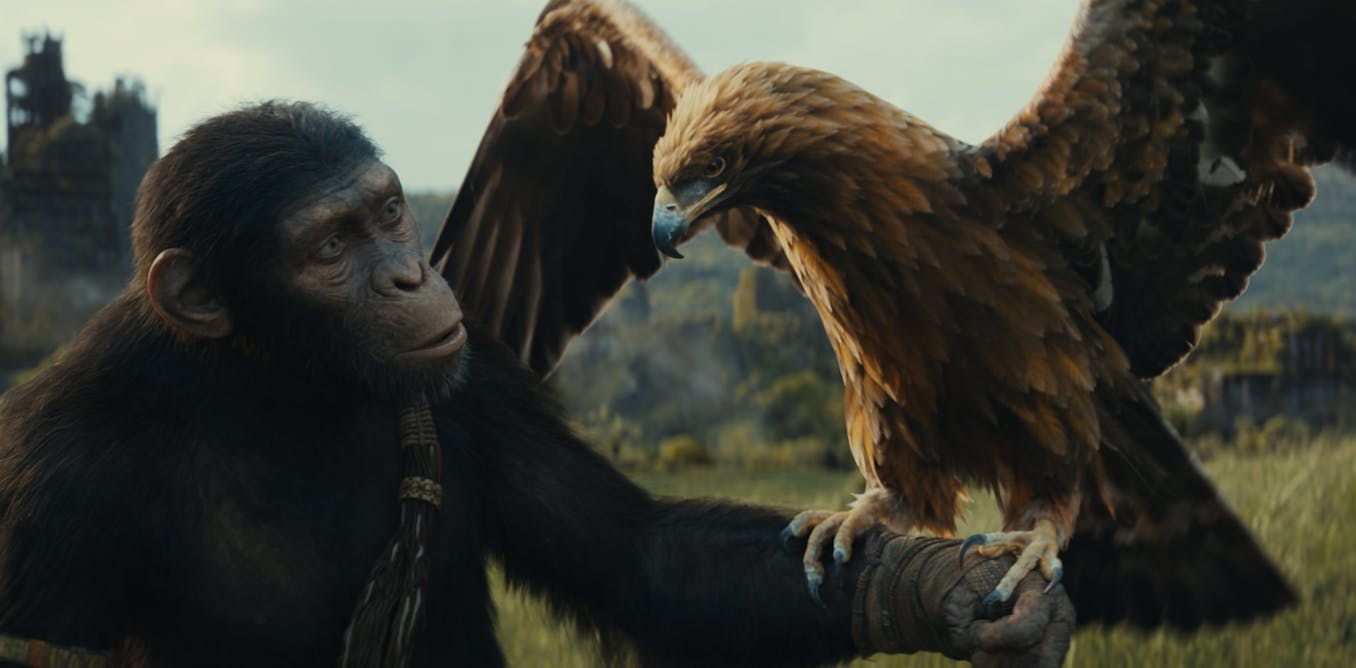Planet of the Apes became the first continuous series of sequels that would become the standard of genre-filmmaking in Hollywood since its first film in 1968. It laid the ground for giants like Star Wars and Star Trek as the first science fiction property to develop a series of sequels alongside live-action and animated TV shows, books, comics and merchandising – from action figures to lunchboxes.
As an expert on Planet of the Apes, it is always exciting to see this groundbreaking franchise continue to be popular. This new film is a strong addition that ties in nicely with the rest of the growing universe.
Kingdom is set 300 years after War for the Planet of the Apes (2017) and the evolution of ape-kind from human companion species to dominant species. Caesar (Andy Serkis), the leader of the apes in the later films of the original series and first three reboots, led his tribe to the promised land. In this sequel, we see the fulfilment of that promise with the Eagle Tribe.
An ape-only world is introduced through Noa (Owen Teague), a young chimp from a falconer-clan of chimpanzees that train eagles to hunt for and protect them. Living in electricity pylons, these apes show how the remnants of human architecture and infrastructure have been rewilded and repurposed for the rise of a new dominant species.
The film follows Noa as he is forced from his paradise home to become a hero as he rescues the Eagle Tribe from enslavement by a militarised clan from “the Forbidden Zone” – a region beyond the land of the Eagle Tribe – under the thrawl of bonobo, Promixmus Caesar (Kevin Durand).
The Forbidden Zone was a central plot point in the original film and its first sequel Beneath the Planet of the Apes (1970). An “ancient taboo” according to orangutan clerics (like Dr Zaius in Planet of the Apes) kept apes away from the desert and coastal region that had evidence (specifically The Statue of Liberty) that showed that humans had once been a keystone species.
In Kingdom, the Forbidden Zone is home to feral humans and non-peaceful ape tribes. It also contains proof that humans were once talking intelligent creatures through books containing knowledge of science, technology, philosophy and human history.
This is the land that Promixmus Caesar comes from. Proximus is a tyrant king who ruthlessly rules with the belief that he is the second coming of Caesar, the original saviour of the apes.
Jabs at organised religion and the way peaceful teachings (in this case those of the original Caesar’s) can be selectively manipulated for control and power hark back to the religious undertones of the original film. Such critiques are explicitly expressed through the idea of a to-be-worshipped proximus (meaning, the next) Caesar, and references to the “Order of Caesar” and the original Caesar of the previous films as “The Lawgiver”. These lay the groundwork for sequels that at least interweave with the original films rather than simply suggesting bland remakes.
Kingdom of the Planet of the Apes is the tenth Apes movie and propels the rebooted franchise towards the far-future world of the original movies. It draws explicitly upon references – including the Forbidden Zone, subterranean colonies, hunting humans, hidden histories, simian saviours and prospective space-bound futures – from the original film and the first wave of sequels and prequels. Although you don’t need to have seen the original series, there were lots of easter eggs hidden throughout that might give some clues as to where the franchise will go next.
20th Century Studios
For those familiar with the original film the references are numerous and extend beyond using names and shoe-horned quotes (Tom Felton’s “take your stinking paw off me you damn dirty ape. My father will hear about this” in Rise managed to disappoint Apes fans).
In particular, I loved the inclusion of the scarecrow crosses to mark the Forbidden Zone. The sampling of Jerry Goldsmith’s original soundtrack is great, as is the recreation of many of the shots from the original film’s human hunt scene with nets and gorillas on horseback, now armed with cattle prods rather than carbine rifles. It showed director Wes Ball’s engagement with the original and the positioning of this film as prequel of sorts to the 1968 film.
Read more:
Oscars 2018: why Andy Serkis has yet again been denied the recognition he deserves
Although I missed Andy Serkis, the motion capture master who ensured that the first three Apes films were taken seriously (although he was involved as an ape camp advisor, the performances of the actors playing apes are dynamic and engaging. Initial unease about having such a CGI-heavy film are soon forgotten after the thrilling opening scenes of Noa and his friends scavenging for eagle eggs to present to their tribe as part of a coming-of-age ceremony.
Similarly, the decision to have production designer Daniel T. Dorrance create real on-location sets to allow as much in-camera shooting as possible – including a beached freight ship which served as the coastal citadel of Proximus Caesar – helps to ground the film and the performances.
Read more:
The Method gone bananas? How motion capture actors are embracing their inner ape
Wētā FX’s digital work is spectacular and the advances since the 2011 rendering of the apes are striking, but sadly the human characters are somewhat two-dimensional. The majority of humans are seen as feral herds ravaged by the mutated simian flu seen in War that turned humans into mute animals.
There are two named human characters, Mae (Freya Allen) and Trevathan (William H. Macy), who both show the worst of humanity’s desire to survive. They set up forthcoming sequels to show that some humans do not succumb to the virus, but will audiences be expected to root for the humans in the future following a ten-film franchise that has so often positioned humanity as unworthy of returning to dominance?

The post “a sharper look as the story gets closer to where it all started in the 60s” by Amy C. Chambers, Senior Lecturer in Film Studies, Manchester Metropolitan University was published on 05/29/2024 by theconversation.com




































